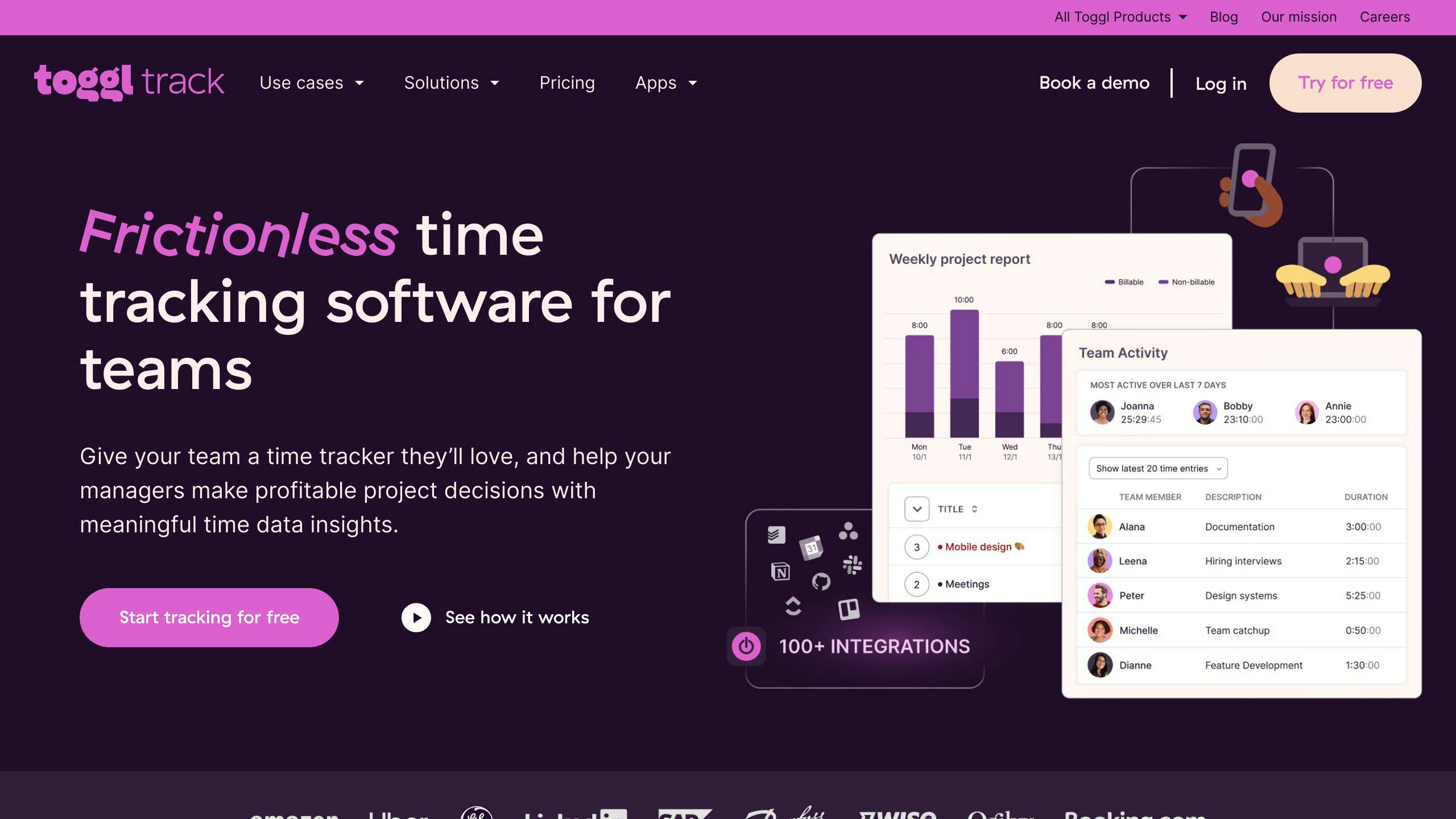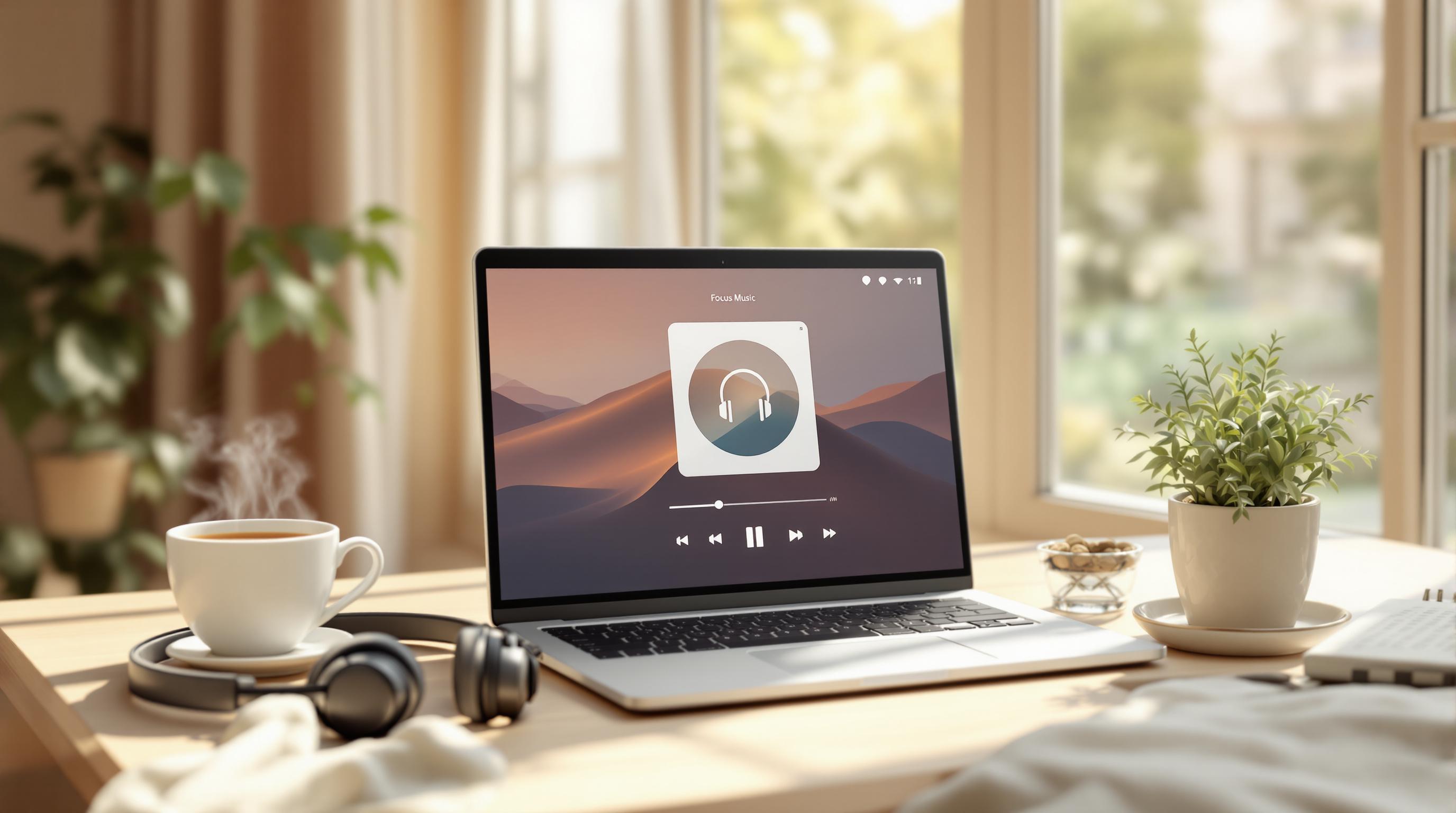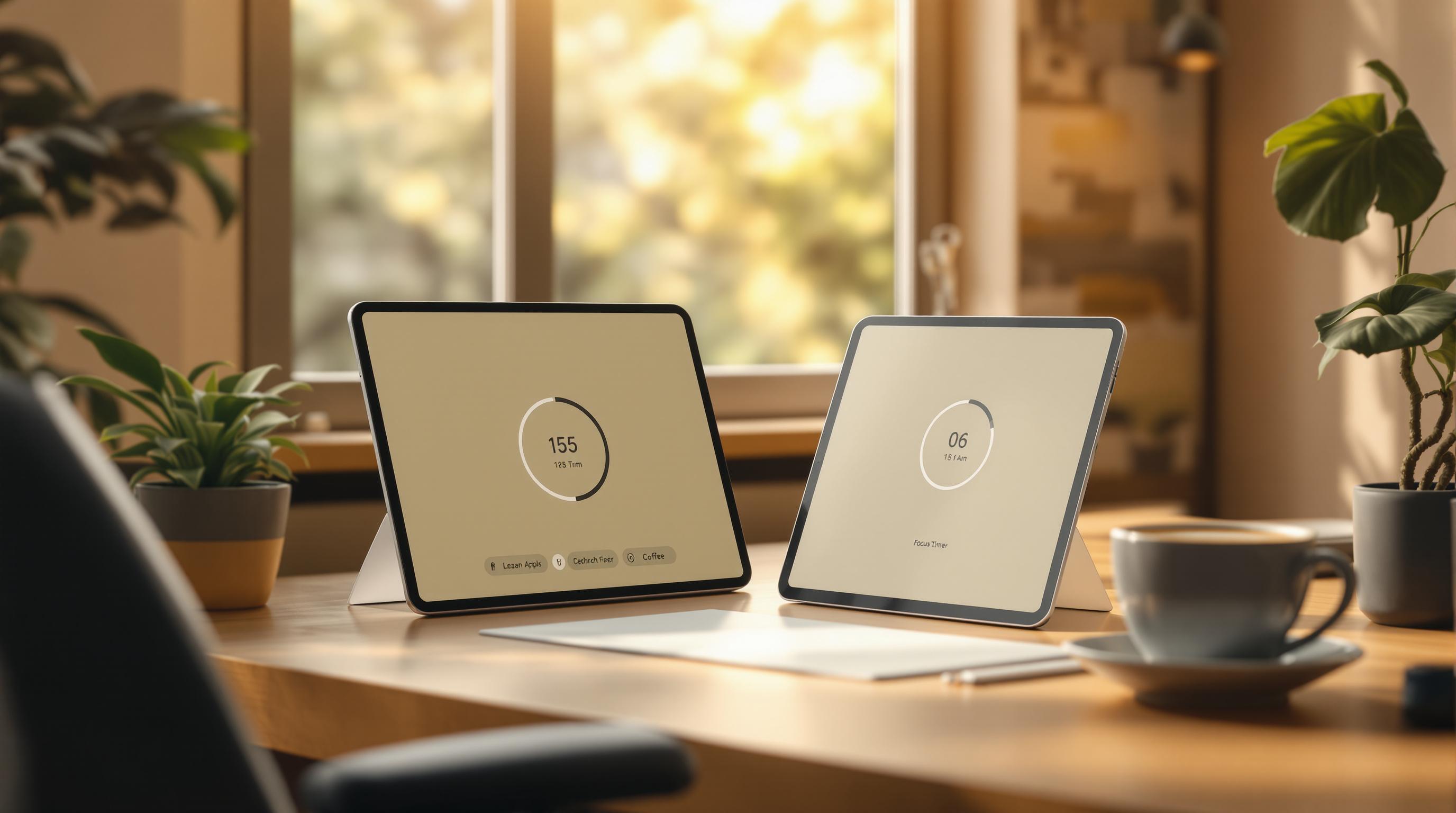Want to boost your productivity? Focus timers might be the answer. Here's what you need to know:
- Focus timers split work into chunks, usually followed by short breaks
- They can increase task completion and productive work time
- Popular tools: Focus App Finder, ActivTrak, and DevDynamics
Key metrics to measure focus timer effectiveness:
- Task Completion Rate
- Time Spent Working
- User Feedback
Quick Comparison:
| Tool | Best For | Main Feature | Price |
|---|---|---|---|
| Pomodor | Simple use | Easy web app | Free |
| Marinara Timer | Team use | Shared timers | Free |
| Forest | Mobile fun | Growing trees | $3.99 (iOS) |
| Session | Mac users | Detailed stats | From $4.99/month |
| Toggl Track | Pro time tracking | Links to billing | Free - $10/user/month |
Choose a timer that fits your work style and needs. Start simple, then explore more advanced options as you get comfortable with the technique.
Related video from YouTube
1. Focus App Finder

Focus App Finder is a one-stop shop for productivity buffs looking for top-notch focus timer apps. It's like a treasure trove of tools to boost your work game, all in one place. But here's the kicker: they don't just list apps. They show you how well these timers actually work using three key measures:
Task Completion Rate
Ever wonder if these focus apps really help you get stuff done? Focus App Finder's got the scoop. Take "Forest" for example. Users who stuck with it knocked out 27% more tasks each week compared to those who used it on and off. That's not just talk - it's based on real data from a three-month study in 2022.
Time Spent Working
It's not just about finishing tasks - it's about how much time you're really putting in. Apps like "RescueTime" team up with focus timers to give you the lowdown on your productive hours. Get this: a group of software developers using "RescueTime" with Pomodoro timers clocked an extra 1.5 productive hours every day over six weeks. That's like gaining an extra workday each week!
User Feedback
Numbers are great, but what about real people's experiences? Focus App Finder's got that covered too. They gather reviews and ratings for each app, so you can see what's actually working for folks like you.
Take the "Be Focused" app. It's sitting pretty with a 4.8-star rating from over 10,000 users. People love how it helps them zero in and get more done. Don't just take our word for it. Here's what one software engineer said:
"After using 'Be Focused' for a month, I've noticed a 40% reduction in the time it takes me to complete coding tasks. The structured focus sessions have dramatically improved my productivity."
That's the kind of real-world impact that can make a difference in your work life.
2. ActivTrak

ActivTrak isn't your typical focus timer. It's a full-blown productivity management system that does way more than just track time. Let's see how it stacks up:
Task Completion Rate
ActivTrak knocks it out of the park here. Its dashboard shows you exactly where time is going - productive stuff vs. time-wasters. This makes it easy to spot bottlenecks and help employees who might be struggling.
Here's a real-world win: A dev team used ActivTrak for six weeks and saw their completed coding tasks jump by 22%. Why? The team lead said ActivTrak helped them cut out the fluff and zero in on what really mattered.
Time Spent Working
ActivTrak doesn't just count hours - it gets into the nitty-gritty of how that time is used. It tracks:
- Deep work vs. multitasking
- Email and meeting time
- Downtime and potential burnout red flags
This detailed breakdown helps everyone understand their work habits and crank up productivity. Get this: A study using ActivTrak data found that people who locked in 2-3 hours of focused work daily were 31% more likely to hit their productivity targets.
User Feedback
ActivTrak doesn't have a built-in feedback system like some focus timers. But it does give insights that make users happy. People love that it balances productivity tracking with employee well-being.
"ActivTrak lets you trust your remote team. It gives you a clear picture of their day-to-day", says a verified reviewer who manages in the Business Supplies & Equipment industry.
This sweet spot between tracking work and caring about employees has earned ActivTrak a solid 4.6 out of 5 stars for being user-friendly.
ActivTrak takes a big-picture view of focus and productivity. It doesn't just time your work sessions - it digs into your work patterns, flags burnout risks, and shows productivity trends. While it's not a traditional focus timer, it's a powerhouse for businesses wanting to supercharge their team's focus and output.
sbb-itb-255d84f
3. DevDynamics

DevDynamics takes a fresh look at focus timer effectiveness by digging deep into engineering team performance. Here's how it stacks up:
Task Completion Rate
DevDynamics nails it with Sprint Performance Reports. These reports don't just count tasks - they dive into sprint completion rates and quality metrics. It's like Jeff Sutherland, the Scrum.org co-creator, says:
"Any Scrum without working product at the end of a sprint is a failed Scrum."
By looking at both quantity and quality, DevDynamics helps teams spot bottlenecks and fine-tune their sprints.
Time Spent Working
DevDynamics knows focus time is key for developer productivity. It tracks and analyzes uninterrupted work periods - crucial when 46% of developers spend less than 20 hours a week on uninterrupted tasks.
Check out these real-world examples:
- Basecamp's "quiet hours" led to developers reporting better productivity and handling of tough coding tasks.
- Microsoft found that interrupted developers took way longer to finish coding tasks compared to those with solid focus time.
- Buffer's "No Meeting Wednesdays" banned non-essential meetings, boosting productivity and code quality.
DevDynamics helps engineering leaders track these focus time initiatives and see how they impact team performance.
User Feedback
DevDynamics doesn't have built-in user feedback like some other tools. But it makes up for it with detailed dashboards that show team performance throughout the development lifecycle.
The tool pushes for transparency in metric tracking, which can boost trust in the organization and team. This fits with the Developer Thriving framework, which looks at four key areas: Agency, Motivation and self-efficacy, Learning culture, and Support and belonging.
With real-time email and Slack alerts, DevDynamics helps teams build better habits and step up their game over time. Engineering managers love this feature for creating a high-productivity environment.
What Works and What Doesn't
Focus timers can boost your productivity, but not all are created equal. Let's break down the pros and cons of some popular options:
Pomodoro Tracker
This web-based tool keeps things simple:
- Easy to use, no fuss interface
- Sticks to the classic 25/5 Pomodoro structure
But it's not perfect:
- Newbies might need time to get the hang of it
- Not much room for tweaking settings
MarinaraTimer
This flexible web timer offers:
- Three Pomodoro modes to choose from
- Freedom to set your own work/break times
The downsides?
- No desktop app for offline use
- The Pomodoro method takes some getting used to
Focus Keeper
iOS users, this one's for you:
- Great for learning the Pomodoro technique
- Tons of customization options
- Tracks your productivity over time
The not-so-great parts:
- iOS only (sorry, Android folks)
- No user guide
- Can't label your focus sessions
Toggl Track

This cross-platform timer packs a punch:
- Handy browser extension
- Plays nice with over 100 productivity apps
- Syncs across web, desktop, and mobile
- Catches idle time to keep your stats accurate
But watch out for:
- The best features cost money
- Browser extension limited to Chrome and Firefox
Here's a quick comparison:
| Tool | Pros | Cons |
|---|---|---|
| Pomodoro Tracker | Simple, web-based | Few customization options |
| MarinaraTimer | Flexible modes, custom timings | No offline desktop app |
| Focus Keeper | Customizable, tracks progress | iOS only, no session labels |
| Toggl Track | Wide integration, syncs everywhere | Paid features, limited browsers |
Picking the right timer depends on your needs. iOS user who wants to dive deep into Pomodoro? Focus Keeper might be your jam. Need something that works with your existing apps? Check out Toggl Track.
Francesco Cirillo, who came up with the Pomodoro Technique, says:
"The structured nature of session work enhances motivation by providing a clear endpoint to tasks."
So, find a timer that helps you stay on track without becoming a distraction itself.
Which Timer Works Best?
Picking the right focus timer can make a big difference in your work. Let's look at some top options for different users:
For Simplicity Seekers
Want something simple? Try Pomodor. It's a free web timer that uses the basic 25/5 Pomodoro setup. Perfect if you just want to start working without any fuss.
For Collaboration Enthusiasts
Marinara Timer is great for teams. You can share timers with unique links. This works well for remote teams or study groups who want to work together.
For Mobile Productivity Gamers
Forest is fun for mobile users. It costs $3.99 on iOS (free with ads on Android). Here's how it works:
"Users plant a tree for each focus session, which grows as they work, promoting productivity through gamification."
Seeing your progress as a growing tree can really help you stay focused.
For Mac Power Users
Session is made for Apple users. The basic app is free, but the Pro version (starts at $4.99/month) has more features:
- Works across Apple devices
- Gives detailed stats
- Connects with your calendar
It's a solid choice for Mac users who want to dig into their work habits.
For Time-Tracking Professionals
Toggl Track is great for freelancers who need to track time and bill clients. The free version tracks time, while paid plans (from $10/user/month) do more.
Here's a quick look at these timers:
| Timer App | Best For | Main Feature | Price |
|---|---|---|---|
| Pomodor | Simple use | Easy web app | Free |
| Marinara Timer | Team use | Shared timers | Free |
| Forest | Mobile fun | Growing trees | $3.99 (iOS) |
| Session | Mac users | Detailed stats | From $4.99/month |
| Toggl Track | Pro time tracking | Links to billing | Free - $10/user/month |
The Bottom Line
There's no perfect timer for everyone. Pick one that fits how you work, what devices you use, and what you need.
If you're a freelancer with lots of projects, Toggl Track might be best. If you're a student, Forest's game-like features could help you study better.
Harry Guinness, a productivity expert, says:
"The Pomodoro Technique is about removing friction, not adding it."
So, choose a timer that makes your work easier, not harder. Start with something simple like Pomodor. As you get used to it, you can try fancier options.
FAQs
How to measure focus time?
Tracking focus time is key to boosting productivity. Here's how you can do it:
1. Use what you've got
Many companies already have tools like Slack, G-Suite, or Office 365. These often come with features to track time spent on tasks. No need for fancy new software - just use what's already there.
2. Ask your team
Surveys are a simple but effective way to gather focus time data. Regular check-ins can reveal a lot about how your team works and what's holding them back.
3. Go digital
Time-tracking apps and personal insights dashboards can automatically log task time. They give you a clear, unbiased picture of where time is going.
4. Set targets
Aim for at least 10 hours of uninterrupted work per week for each employee. That's about 2 hours a day. Look for 60-minute or longer blocks in calendars to spot deep work time.
5. Listen up
One-on-one meetings are gold. They help you understand what's working and what's not for each team member. Use these chats to clear obstacles and get everyone back on track.
Remember, it's not just about how much time you spend focused, but how well you use it. As productivity guru Cal Newport says:
"The highest-performing students studied less, and spent less time writing essays, than the group below them. They simply eliminated distractions to stay hyper-focused."
So, don't just clock hours - make those hours count.


